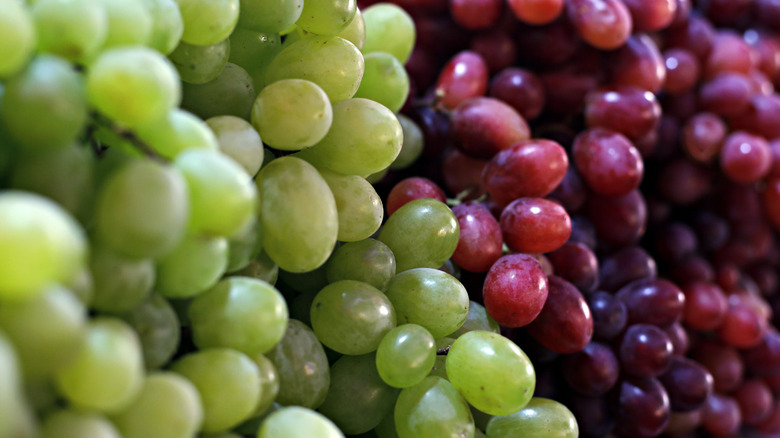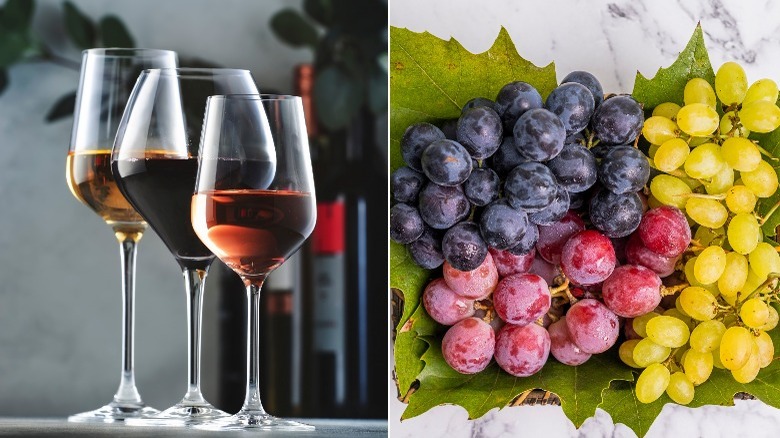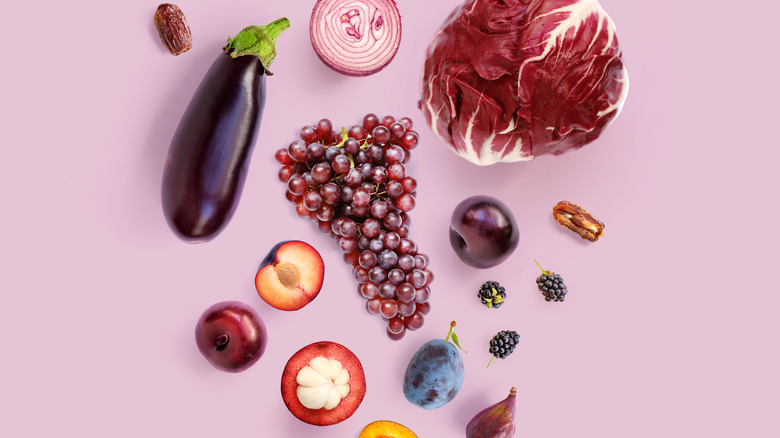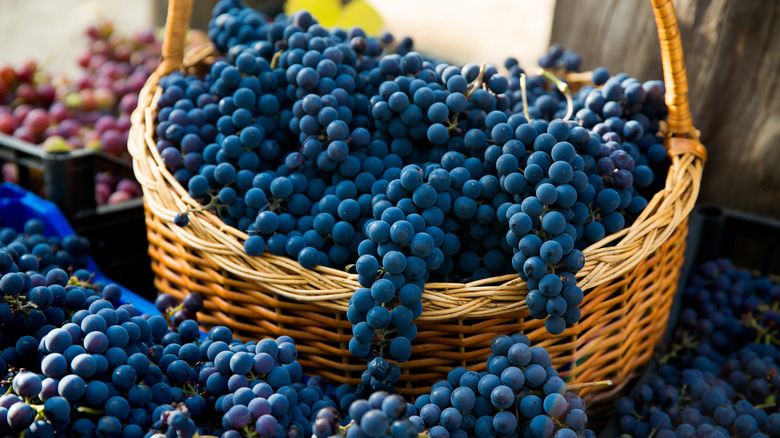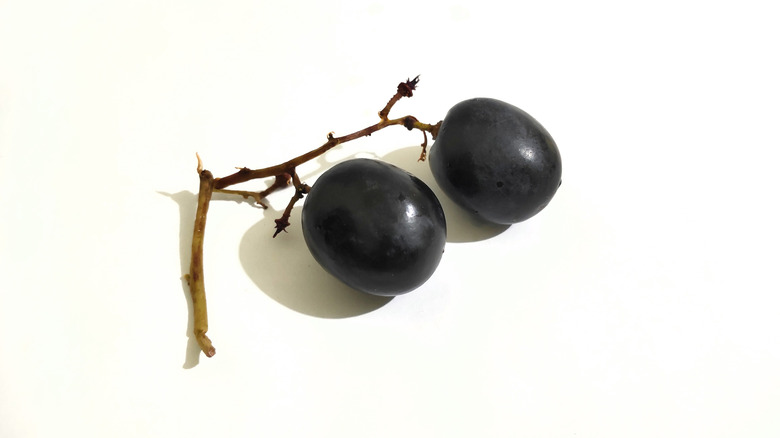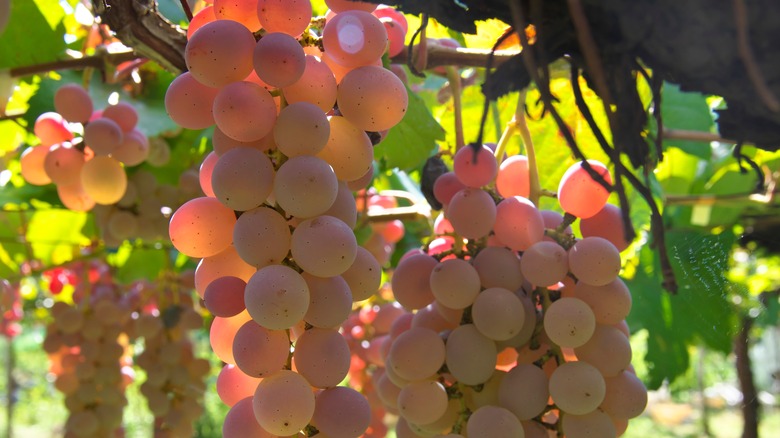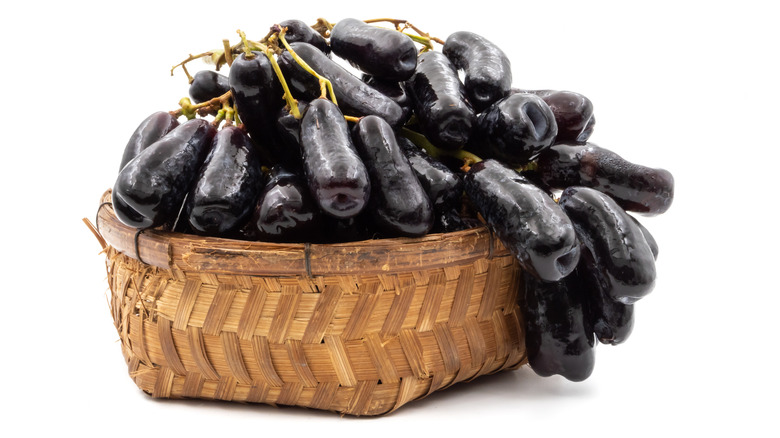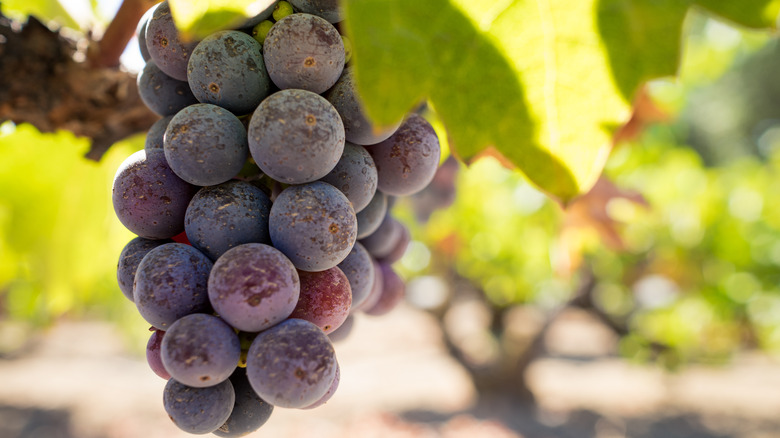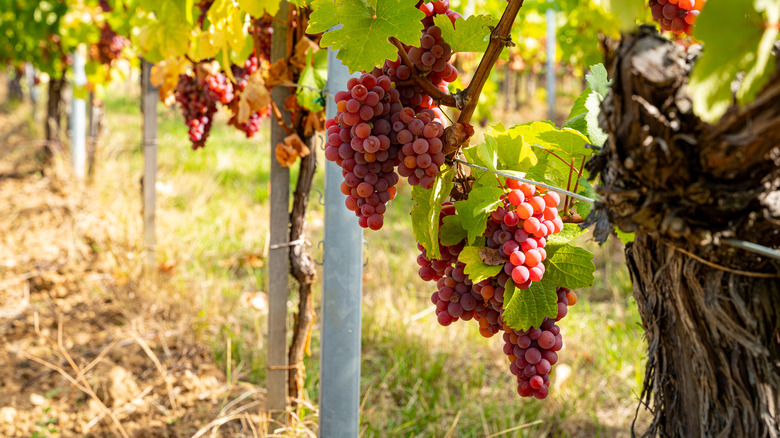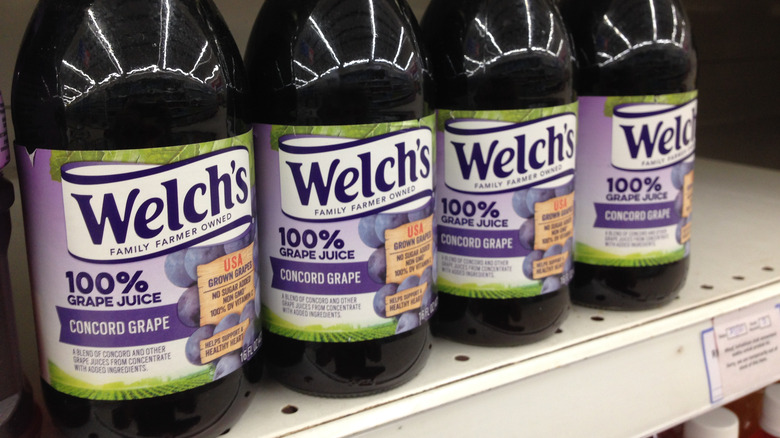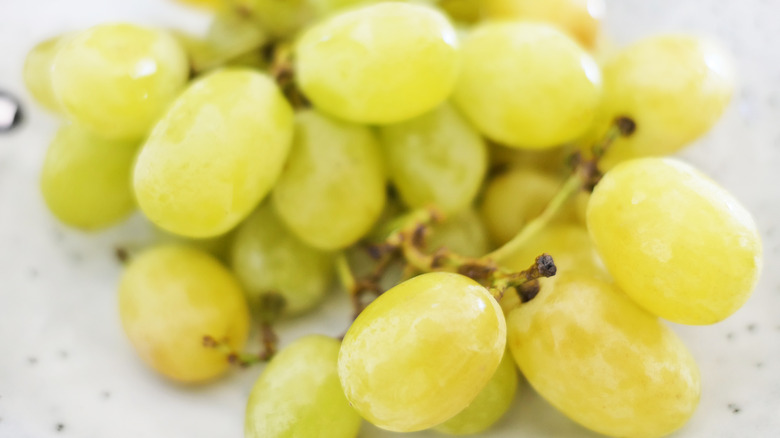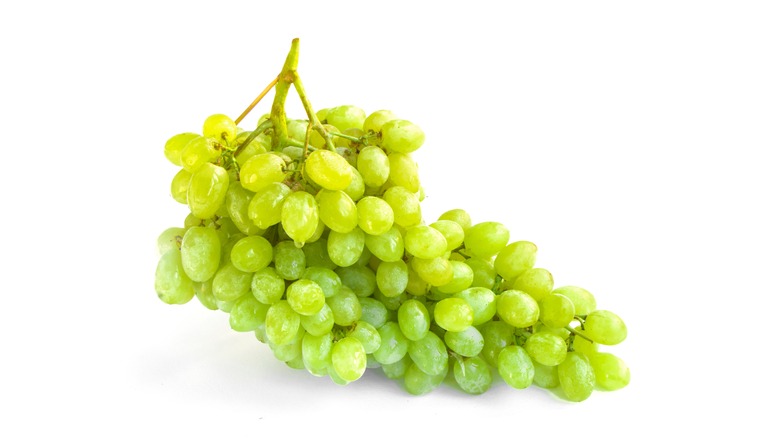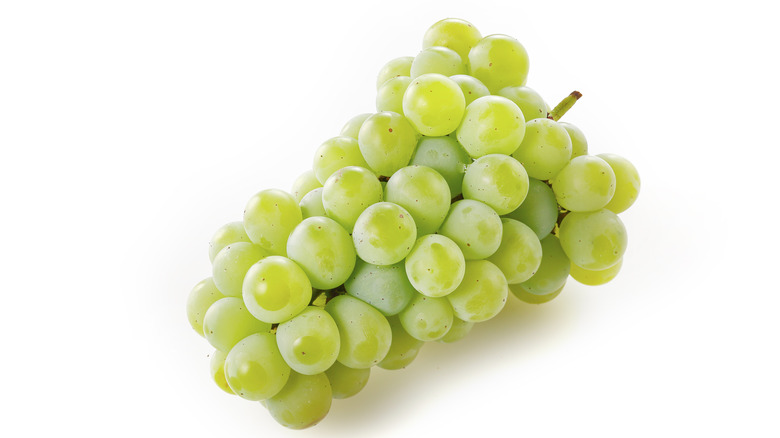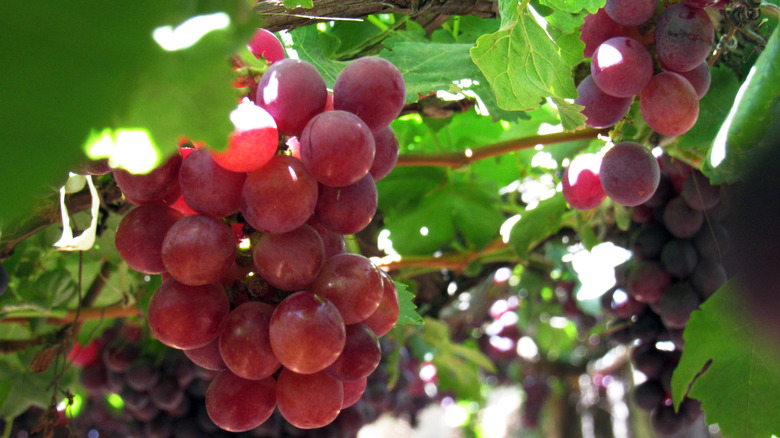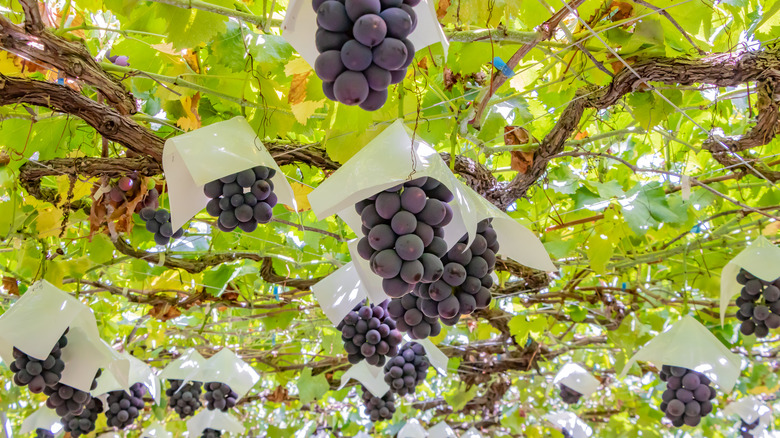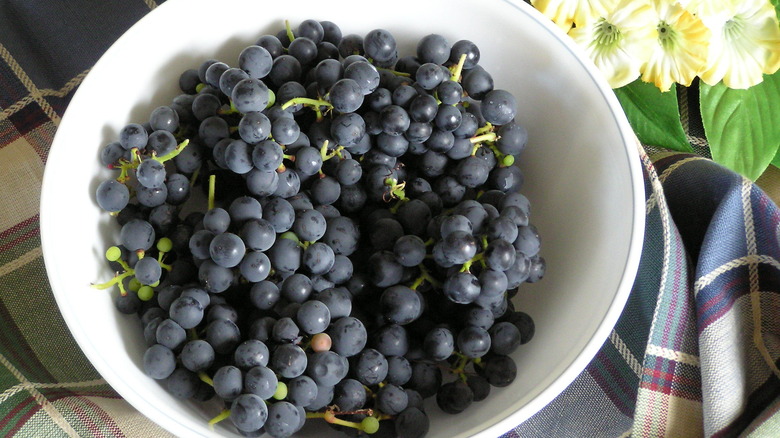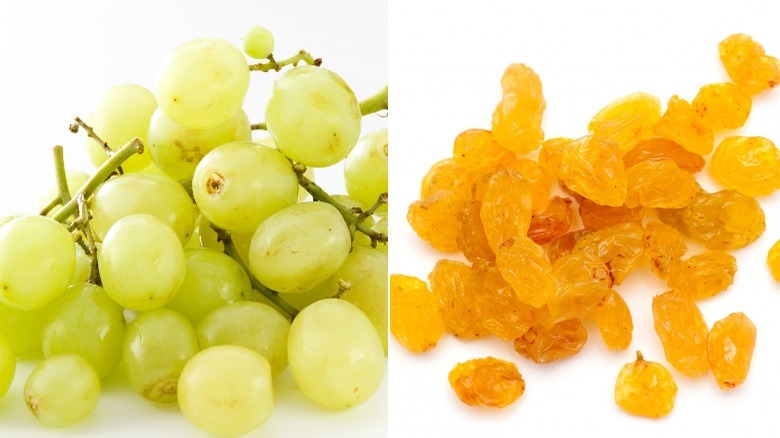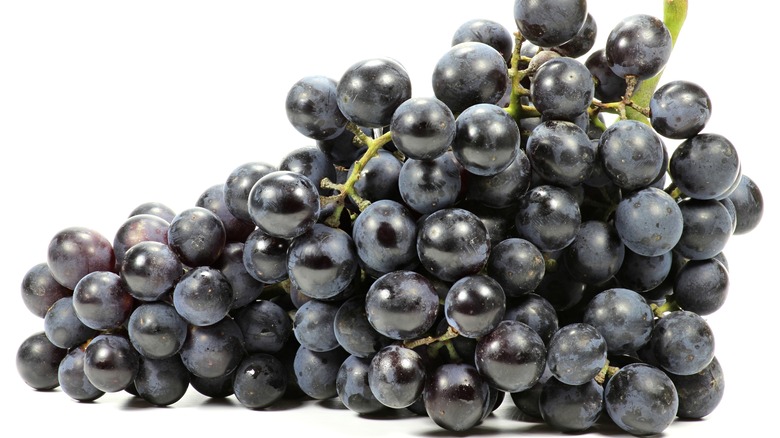17 Different Types Of Grapes Explained
What is a grape and where are they grown?
Some vegetables are berries and some fruits are vegetables, but what are grapes? According to Britannica, grapes are berries, usually growing in clusters on vines that can reach up to 56 feet. Grapes appear in many different colors, from pale green to red to nearly black. They are usually spherical, although they can also come in more elongated shapes. The leaves are also edible, and appear in many cuisines and dishes (such as Greek dolma).
Grape cultivation is very old, with grape production shown in Egyptian hieroglyphics from as early as 2400 BCE (per Britannica). Grapes have spread across the world, and they are highly adaptable, able to be grown in many different soils and climates.
According to the Agricultural Marketing Resource Center, Spanish missionaries are credited with bringing European varieties of grapes to the United States in the 1700s. With California's mild climate providing perfect grape-growing conditions, it soon became the leading grape state, although most other states (notably Arkansas, Georgia, Michigan, Missouri, New York, North Carolina, Ohio, Oregon, Pennsylvania, Texas, Virginia, and Washington) also contribute to America's nearly six million tons of grapes grown per year.
Grapes grown in the States are made into wine, jams, jellies, and juices, eaten fresh, and dried as raisins. But what different types of grapes are there?
Eating grapes vs. drinking grapes
While all grapes are delicious, many lend themselves to being prepared in specific ways. Table grapes, for example — those we give to kids as snacks or put out at parties — are often seedless, large, sweet, and firm, with thin skins. They make great raisins in their later years (per Epicurious).
Juice grapes have thicker skins, with delicious, pulpy insides. They're used for making jams, jellies, and grape juice. They're also edible, although some grapes like the native American Concord grape (hailing from Concord, Massachusetts, per the Concord Grape Association) have a slip skin — a thick skin that slips easily off the inner pulp, which makes them extra fun to eat.
But why can't you make wine out of grapes you bring home from the store? As Vine Pair explains, wine grapes are quite different from table grapes. It basically comes down to four major points: species, skin, sugar, and size. All wine grapes come from the Vitis vinifera species, while table grapes include other species. Wine grapes have thicker skins, which gives wine its great color and those mouth-drying tannins.
Lastly, wine grapes tend to be much smaller (and there are fewer of them). This concentrates the flavor and the sugars — wine grapes are much sweeter than table grapes, which is great because that sugar is what the yeast devours to make the alcohol. Table grapes are bigger because they contain more water, which dilutes that sugar (but means more juice!).
Are grapes good for you?
Whether it's 100% true or not, we all like to read about how the French drink red wine for their health. But is eating grapes good for you? Like all fruits and vegetables, a serving of grapes definitely counts as one of your five a day, and their sweet taste makes it easy to eat several handfuls.
According to Healthline, grapes are high in polyphenols, which give fruits their colors and are a great source of antioxidants. Polyphenols also have anti-inflammatory and anti-platelet effects, and support good artery health. Grapes also support eye health by assisting with retinal function, and may also help to improve blood sugar levels and blood pressure.
Eating grapes regularly will also provide your body with vitamin K (which helps your blood clot when necessary) and a small amount of fiber. So yes, grapes are good for you. Even though they are high in sugar, grapes are considered a low G.I. (glycemic index) food, meaning that they do not cause your blood sugar to spike and then crash, but slowly release the sugar into your blood over time.
Looking for a grape to eat? Here are 17 different types of grape, explained.
Pinot Noir grape
The pinot noir grape is used to make pinot noir wine, one of the world's most popular red wines (according to Wine Folly). The grape likely originated in Burgundy in central France, where they were tended by Cistertian monks in the Middle Ages, and it is commonly made into white, red, rosé, and sparkling wine.
Pinot noir grapes are grown mostly in France and the U.S.A., particularly in the West Coast states of California, Oregon, and Washington, but are also grown in Australia, New Zealand, and Chile, as well as Germany, Switzerland, Moldova, and Italy.
These grapes like mild weather, with a cooler climate and a longer growing season, which is why they thrive in Northern and Central California and the valleys of Burgundy. French pinot noir has an earthier, more floral taste with higher tannins (those things that dry your mouth out, but in a good way!), while Californian pinot has a richer, fruitier taste.
We'll have to try them both, just to be sure.
Sweet Jubilee grape
What if you want an apple that's actually a grape? You want a Sweet Jubilee (or a bunch of them!). These grapes are huge, which makes them perfect for slicing on top of a peanut butter sandwich (freshest jelly ever) or grilling on the barbecue to elevate your salad.
The Good Fruit Guide reports that Sweet Jubilee is a firm, purple-black grape with sweet, slightly greenish flesh, tasting sweet with just a hint of acidity. These grapes are harvested in California in late August, but are also grown in Spain, Chile, and Brazil.
According to The Produce News, Sweet Jubilee grapes are grown by The Grapery, a California grape company who produce many unusual and exciting grape flavors.
This grape does sometimes feature seeds, but as the grapes are so big they can be sliced and the seeds easily removed – again, like an apple! (We might need a new saying to replace the old apple maxim. Maybe "Try Sweet Jubilee and you'll be doctor-free?" It's a work in progress.)
Koshu grapes
You might associate Japan more with sake or whisky, but there is a Japanese grape varietal that makes excellent wine: the Koshu grape. As The Drinks Business explains, Koshu grape wine has a delicate flavor that is a perfect accompaniment for many of the common features of Japanese cuisine, from the clean taste of sashimi to that amazing umami flavor we love in miso and ramen.
Koshu grapes aren't just unique in terms of flavor. They're also quite beautiful, found in a dusky pink color. They are related to a grape found in the Caucuses, and it is theorized that they may have traveled to Japan via China, having been brought in on the Silk Road around 1,000 years ago.
Today, Koshu grapes are grown in the Yamanashi wine region of Japan, on the island of Honshu near Tokyo, which encompasses the volcanic northern slopes of Mt Fuji. Koshu apparently has a subtle, fresh, bready, citrus taste with a hint of salt.
Moon Drops grapes
Remember what we said above about The Grapery and their wild grape-creating ways? Well, the innovative company has a grape varietal that is spooky, sweet, and seasonal enough to double as Halloween candy: Moon Drops.
With their deep purple hue, these little guys kind of look like tiny aubergines or licorice, but they're actually super sweet and crunchy (per Specialty Produce). Moon Drops are in high demand, and they have a pretty short season — from late August to the end of November, according to The Grapery.
Moon Drop grapes are seedless, and so crispy that they can be snapped in two like a carrot! A popular way to eat them (apart from by the fistful) is to cut them in half lengthwise and stuff them with salty cheese, which sounds absolutely delicious.
If you're looking to class things up around here, pair your Moon Drops with salt (think mixed nuts), lemon, or poultry.
Zinfandel grapes
The Zinfandel grape also goes by the name of Primitivo (according to Wine Folly). The grape makes an amazingly delicious, round, bold red wine, as well as a sweet rosé called White Zinfandel.
Red Zin has a jammy, fruity taste with notes of smoke and a decent serving of tannins. The grapes tend to ripen unevenly, so they have to be left on the vine for longer. This long ripening period means that the grapes develop higher levels of sugar, which means that Zinfandel wines tend to be high in alcohol, too — around 15% A.B.V. It's definitely the kind of wine you want to drink on a winter's night by the fire, but the rich flavors also pair perfectly with a plate full of barbecue. It may be one of the best red wines for cooking with, but we definitely recommend drinking it instead.
The Zinfandel grape originates from Croatia, and the vines were first brought to California in the late 1800s. White Zinfandel is a more recent invention, dating back to the 1970s. It's very sweet, so if you like regular Zin, be sure to read the label!
Gewürztraminer grapes
Gewürztraminer is a German grape varietal. The grape has a pretty pink skin that makes a beautiful golden white wine. According to The Wine Society, the word Gewürz in German means spice, although the wine often tends toward sweetness in taste.
However, keep that translation in mind when it comes to selecting a wine for dinner — Gewürztraminer pairs beautifully with curry and other spicy foods. The grapes are most commonly grown on the foothills of the Alps in Europe. In particular, the most famous Gewürztraminer wines come from the French-German border region of Alsace, but it is also widely grown in New Zealand and South Africa, where it prefers cooler climates.
It's noted for its strong floral smell and its difficult-to-pronounce name! For the record, it's a hard g, something like geh-verz-tra-mee-ner. (Now that you know how to say it, find out why Gewürztraminer is one of the white wines you need to know.)
Concord grapes
Here is a true American grape, a grape that's been part of American viticulture — that's "grape farming" to you and me — since 1843 (according to Specialty Produce).
Concord grapes hail from Concord, Massachusetts. They have wild New England ancestors, as well as a reputation as the only answer to what jelly to put in a peanut butter and jelly sandwich. Yes, the Concord grape is the main ingredient of proper grape jelly. They're also used to make grape jam, and to make the most famous grape juice of all: Welch's, which is made out of 100% Concord grape juice (per their website).
Today, Concord grapes are grown mostly in Washington and New York states, as well as in Michigan, Pennsylvania, and Ohio (via the Concord Grape Association). Most grapes are grown for juice production, but they can be found and bought as table grapes in some areas during the fall harvest season.
Perhaps most intriguingly, the Association states on their website that it is possible to make 100% Concord grape juice into 100% Concord grape wine. Apparently, all you need is the right strain of yeast! Something to consider.
Cotton Candy grapes
Another one from the innovators at The Grapery, Cotton Candy grapes come in colors ranging from sunshine yellow to green. The surprise comes when you bite into them — they taste exactly (and we mean exactly) like your favorite spun sugar carnival treat, cotton candy.
These super sweet treats have a very short season; they're only available from the middle of August to the end of September, which means demand tends to be high. So if you can get your hands on some, try freezing them to make them last longer.
Cotton Candy grapes are sweet enough that you can replace actual candy with them, but with a few more benefits than just pure energy. As like all grapes, they're high in antioxidants, as Specialty Produce explains. They're also great in sweet baked goods such as muffins, or on top of a bowl of ice cream or other dessert.
Centennial grapes
One of the most convenient developments in food science has been removing the seeds from tons of different fruits and vegetables for our eating pleasure. Enter the Centennial grape, now going on nearly 70 years of making our snack breaks a time for stress-free chewing. Noble food scientists, we salute you.
As Plant Grape explains, the Centennial grape is a large, green, seedless grape, firm in texture, with a sweet, delicious taste. It was first bred in California (the home of innovative grape science, as we've learned!) in 1966, and is now widely cultivated in France. It's a popular table grape for its versatility and size, as at home in a fruit salad as it is on your cheeseboard, or even in the oven on its way to becoming a raisin!
We hear that some people put grapes on pizza, too, and the Centennial grape would be a grape candidate for that. Sorry, a great candidate.
Niagara grapes
Looking for a grape that can do it all? Shade your pergola, make jelly, produce a sweet white wine or a delicious grape juice, and charm your dinner party guests on a cheeseboard? You want the Niagara grape.
As Gardenia explains, the Niagara grape is extremely popular for all of the above reasons. It's a large, juicy, round, green grape, with a very decorative, leafy vine. Specialty Produce notes that the Niagara grape is a cross between our old friend the Concord grape and the less common Cassady grape.
Niagara grapes are named for their homeland of Niagara County, New York. They came out of the Concord Grape Belt, a chunk of the Northeast that is the oldest grape growing region in the United States. Move over, California!
These grapes are available from the late summer through the early fall, and are the variety most often found in white grape juice.
Red Globe grapes
Red Globe grapes are true to their name. As Good Fruit Guide explains, they have a color ranging from light pink to dark red, as well as a round shape. Red Globe grapes are large, and although they have seeds, they're worth the inconvenience to eat because the flavor is so good. Think crunchy, sweet, juicy, delicious grapes. They would taste amazing frozen on a hot summer day!
These grapes were developed in California in the 1950s, and are apparently most popular today outside the West because we have become so accustomed to seedless grapes. We recommend getting over it, because Red Globe grapes are worth the extra work.
Today, they are mostly grown in the U.S., Mexico, Argentina, Chile, Peru, South Africa, and Australia, as well as China, Italy, and Spain. These large grapes would be amazing sliced (and the seeds removed) and layered in a muffin, tart, or fruit salad.
Kyoho grapes
If you're in Japan and craving a Concord grape-like snack, pick up a bunch of Kyoho grapes — but you'll have to go to a high end grocer to find them.
As Specialty Produce explains, Kyoho grapes were developed in 1937 by Yasushi Oinoue, who crossed Ishiharawase grapes and Centennial grape varieties. He named his new grape Kyoho, which translates to great mountain peak, in honor of Mt. Fuji (which he could apparently see outside his window).
Kyoho grapes are large, round, dark purple grapes, with a slip skin (again like the Concord) allowing the bitter skin to be removed before eating. The flesh is juicy and sweet, with a few seeds. In Japan, Kyoho grapes are a symbol of friendship, often given as luxury gifts. They fetch high prices because they are difficult to cultivate; indeed, the process is considered an art form in Japan.
Each bunch is carefully pruned and shaped to contain only 30 to 35 perfectly, evenly spaced berries of similar size. This is because it is believed that a bunch with too many grapes will not taste as sweet.
Riesling grapes
The Riesling grape produces one of the most contentious wines around. It's the one that's sold in the tall, thin bottle. Riesling has a reputation for being a sweet wine, but it also comes in a dry variety that is really delicious.
According to The Wine Society, Riesling grapes do well in a cold climate, as they are very frost-resistant. The grapes themselves are small, pale green, and form bunches with many grapes.
Their reputation for making a sweet wine comes from the fact that they are susceptible to a mold called noble rot, which dries them out and increases their sweetness.
Riesling is most commonly grown in Germany and along the French-German border, particularly in Alsace, as well as in the New World (specifically the cooler parts of Australia and New Zealand).
Good Riesling has floral aromas and citrusy tastes, especially lime, along with a good dollop of honey. Try it cold on a summer's day! It's definitely not one of the best white wines for cooking with, though. Better drink it instead.
Valiant grapes
Do you live in a climate so cold you can't grow your own grapes? Give Valiant grapes a try.
As Gurney's explains, these grapes were bred by the University of South Dakota especially for growing in the Northern climes. The grapes themselves are small and blue, with a slip skin like the Concord grapes, and a sweet, tangy flavor. They make amazing jams and jellies, as well as grape juice. However, they can also be eaten fresh as table grapes.
Valiant grapes are among the most cold-resistant and hardy grape varieties, grown mainly in Minnesota and South Dakota (per Wine Searcher). And yes, it is possible to make wine out of them! As long as the grapes are left on the vine for long enough before they're harvested, their sugar content should be high enough for a bit of home wine-making. (While they're ripening, why not read about the foot-stomping wine-making tradition?)
Thompson Seedless grapes
This is the original, most basic, reliable, green seedless grape: the Thompson. It's large, it's crisp, it's sweet, and it is the most widely planted grape varietal in California (per the University of California).
A staggering 70% of the annual Thompson Seedless harvest is devoted to raisin production, as it is the premier raisin grape on the market today. The remainder of the crop goes to table grapes, wine, and grape juice concentrate, among other uses.
Although the Thompson Seedless grape was bred in California, it is the same as the Sultanina grape grown in what is now Turkey, and is known by several other names around the world. Confusingly, light-colored raisins are known as sultanas in many other parts of the Western world, including the United Kingdom, New Zealand, and Australia (per Healthline).
Whatever you call them, it's a fact that Thompson Seedless grapes are nearly as delicious dried as they are fresh.
Black Muscat grapes
These grapes are seriously versatile. They make a great accompaniment to cheese. In their wine form, they're perfect paired with dessert or a main course.
As The Back Label explains, these grapes go by many different names, too: Muscat de Hambourg, Black Hamburg, Muscat Hamburg, Golden Hamburg, and even Muscat Gamburgskiy. Muscat vines grow well almost everywhere in the world, but the Black Muscat as we know it today was first bred by an Englishman in 1850, who crossed a German red grape with Muscat of Alexandria (a green grape) to form the Black Muscat.
It gets its name from its rich, dark color, and while Black Muscat makes a dessert wine in France, in other parts of Europe it's made into a regular red wine for the table. In the United States, it's grown in Virginia, New York, Texas, and of course the West Coast, where it's found with sweet notes of lychee.
Black Muscat grapes (or wine!) are known for going particularly well with chocolate, so adjust your Valentine's Day plans accordingly.
